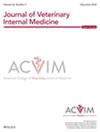Association of Extreme Brachycephaly With Persistent Fontanelles in Adult Chihuahuas
Abstract
Background
Although persistent fontanelles (PFs) are common in adult Chihuahuas, their association with cranial morphology remains unknown.
Objectives
To identify whether cranial morphology is associated with PFs in Chihuahuas and if bodyweight is associated with cranial morphology in this breed.
Animals
Fifty client-owned Chihuahuas.
Methods
In this retrospective cross-sectional study using computed tomography images, we measured two different cranial base lengths (1 and 2), cranial length, height, and width, and two craniofacial angles. We calculated the ratios of cranial height to cranial base lengths 1 and 2, cranial height to length, cranial height to width, and cranial width to length (cranial index [CrI]). We evaluated if total PF area and number of cranial sutures affected by PFs were associated with craniometric measurements and their ratios and craniofacial angles. Additionally, we evaluated if the craniometric ratios were associated with bodyweight.
Results
Total PF area was larger and number of cranial sutures affected by PFs higher in dogs with higher cranial height to cranial base length ratios 1 (estimate, [95% confidence interval], p: 2.295, [1.204–4.377], p = 0.01 and 1.720, [1.212–2.442], p = 0.002, respectively) and 2 (1.203, [1.069–1.354], p = 0.003 and 1.087, [1.011–1.169], p = 0.02, respectively) and CrI (1.225, [1.079–1.391], p = 0.002, and 1.134, [1.057–1.215], p < 0.001, respectively). Higher CrI was associated with lower bodyweight (−2.600, [−4.102 to −1.098], p = 0.001).
Conclusion and Clinical Importance
Our results suggest that in Chihuahuas, lower bodyweight is associated with more extreme brachycephaly and extreme brachycephaly is associated with PFs.


 求助内容:
求助内容: 应助结果提醒方式:
应助结果提醒方式:


